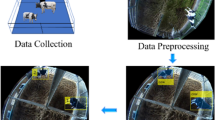Abstract
Estrus detection in cattle is an important factor in livestock farming. With timely estrus detection, cattle are artificially fertilized and isolated for safety, which directly affects the productivity of livestock farms. Estrus can be successfully detected by identifying the mating posture of cattle. Therefore, in this paper, we propose the identification of cattle mating posture based on video inputs for prompt estrus detection. A deep learning-based object detection network that focuses on real-time processing with high processing speeds is applied. The use of deep learning-based object detection shows high accuracy, even with noise robustness. The performance of the network is improved through the inclusion of an additional layer and a new activation function. The composition of the additional layer enables training by extracting more features required for object detection. The application of the new activation function, Mish, which has a smoother curve, allows for better generalization and improves the accuracy of the results. The data needed for training were gathered by installing cameras at a livestock farm, and various datasets were used depending on camera placement. The results of this study were verified by the evaluation of four networks using test datasets containing image and video data from different environments. The identification of the mating posture of cattle attained 98.5% precision, 97.2% recall, and 97.8% accuracy.







Similar content being viewed by others
References
Korean Statistical Information Service. The global cattle population
Roelofs J, López-Gatius F, Hunter R, VanEerdenburg F, Hanzen C (2010) When is a cow in estrus? Clinical and practical aspects. Theriogenology 74:327–344
Ryu I-S (2006) Accurate Understanding of Cattle Insemination. Improvement for Breeding Stock 11:38–42
Saint-Dizier M, Chastant-Maillard S (2012) Towards an automated detection of oestrus in dairy cattle. Reprod Domest Anim 47:1056–1061
Kim B, Lee Y, Kim Y, Kim T, Park J, Lee S (2017) Top 10 Agriculture Issues in 2017. In: Korea Rural Economic Institute, Focus on Agricultural Affairs, vol 142, pp p1–27
Higaki S, Miura R, Suda T, Andersson LM, Okada H, Zhang Y et al (2019) Estrous detection by continuous measurements of vaginal temperature and conductivity with supervised machine learning in cattle. Theriogenology 123:90–99
Kamilaris A, Prenafeta-Boldú FX (2018) Deep learning in agriculture: a survey. Comput Electron Agric 147:70–90
Jun H, Kim J (2015) Remote multiple sensor network system for monitoring conditions of dairy cow. J KIIT 13:85–93
Roelofs J, Van Erp-van der Kooij E (2018) Estrus detection tools and their applicability in cattle: recent and perspectival situation. Animal Reprod (AR) 12:498–504
Andersson LM, Okada H, Miura R, Zhang Y, Yoshioka K, Aso H et al (2016) Wearable wireless estrus detection sensor for cows. Comput Electron Agric 127:101–108
Arave C, Albright J (1981) Cattle behavior. J Dairy Sci 64:1318–1329
Zhao Z-Q, Zheng P, Xu S-T, Wu X (2019) Object detection with deep learning: a review. IEEE Trans Neural Netw Learn Syst 30:3212–3232
Tsai D-M, Huang C-Y (2014) A motion and image analysis method for automatic detection of estrus and mating behavior in cattle. Comput Electron Agric 104:25–31
Chung Y, Choi D, Choi H, Park D, Chang H-H, Kim S (2015) Automated detection of cattle mounting using side-view camera. KSII Trans Internet Inf Syst 9:3151–3168
Ke S-R, Thuc H, Lee Y-J, Hwang J-N, Yoo J-H, Choi K-H (2013) A review on video-based human activity recognition. Computers 2:88–131
Redmon J, Farhadi A (2018) Yolov3: An incremental improvement. arXiv preprint arXiv:1804.02767
Lin T-Y, Goyal P, Girshick R, He K, Dollár P (2017) Focal loss for dense object detection. In: Proceedings of the IEEE international conference on computer vision, pp 2980–2988
Wu Z, Shen C, Van Den Hengel A (2019) Wider or deeper: revisiting the resnet model for visual recognition. Pattern Recogn 90:119–133
Laurent T, James B (2018) The multilinear structure of ReLU networks. In: International conference on machine learning, pp 2908–2916
Misra D (2019) Mish: a self regularized non-monotonic neural activation function. arXiv preprint arXiv:1908.08681
Liu Q, Furber S (2016) Noisy Softplus: a biology inspired activation function. In: International conference on neural information processing, Springer, Cham, pp 405–412
Acknowledgements
This work was supported by the National Research Foundation of Korea (NRF) grant funded by the Korea government (MSIT) (No. 2017R1E1A1A03070297). This research was supported by the MSIT (Ministry of Science and ICT), Korea, under the ITRC (Information Technology Research Center) support program (IITP-2020-2018-0-01433) supervised by the IITP (Institute for Information & communications Technology Promotion).
Author information
Authors and Affiliations
Corresponding author
Additional information
Publisher's Note
Springer Nature remains neutral with regard to jurisdictional claims in published maps and institutional affiliations.
Rights and permissions
About this article
Cite this article
Chae, Jw., Cho, Hc. Identifying the Mating Posture of Cattle Using Deep Learning-Based Object Detection with Networks of Various Settings. J. Electr. Eng. Technol. 16, 1685–1692 (2021). https://doi.org/10.1007/s42835-021-00701-z
Received:
Revised:
Accepted:
Published:
Issue Date:
DOI: https://doi.org/10.1007/s42835-021-00701-z




